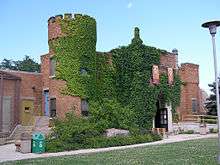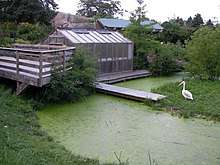Racine Zoo
The Racine Zoological Gardens, or Racine Zoo, is a zoo situated on 28 acres (11 ha) on the shore of Lake Michigan in Racine, Wisconsin. The zoo is operated by the Racine Zoological Society, a non-profit organization. With more than 100 species of animals,[3] the zoo's collection focuses on species native to Wisconsin, including a building dedicated to reptiles and amphibians that are indigenous to the state.
 The primate building | |
| Date opened | 1923[1] |
|---|---|
| Location | Racine, Wisconsin, United States |
| Coordinates | 42.7488°N 87.7837°W |
| Land area | 32 acres (13 ha)[1] |
| Memberships | AZA[2] |
| Website | racinezoo |
History
The Racine Zoo was founded on March 1, 1923, by local businessman Jacob Stoffel, Jr. His donation of three monkeys spurred the city of Racine to build a small zoo in Island Park. By the end of that year, the zoo featured deer, badgers, gray foxes, and Rocky Mountain goats. After it outgrew the space, the zoo's current location at Goold Street and North Main Street, opened in 1925. The site had previously been part of Lakeview Park, which was a former brickyard.
The Racine Zoo quickly grew in its new location. Between 1925 and 1929, it added exhibits featuring sea lions, hoofed animals, and bears. A duck pond was created by flooding an abandoned clay quarry. During the Great Depression, the zoo's free admission allowed it to thrive while others were forced to close. The castle-like Vanishing Kingdom, which houses big cats and primates, was completed in 1939. It was built using bricks from the former county jail.

On May 23, 1958, Mary Heibner, a ten-year-old girl from Waukegan, Illinois, was mauled by a bear at the zoo. She nearly lost her right arm and required plastic surgery.[4]
In November 1959, due to overcrowding, the Como Park Zoo relocated a two-year-old Siberian tiger to Racine. The Racine Zoo purchased the tiger, named Kahn, the following year.
On May 13, 1985, 35 ducks, geese and swans living in the zoo's duck pond were put down after the zoo was hit by a plague of duck viral enteritis.[5]
In November of that year, the zoo became the host of the Kiwanis-Wheary Lights, an annual holiday light display. The lights were the creation of George H. and Jessie May Wheary, who held the display at their home in North Bay from 1962 to 1982. The lights were shown in Monument Square until Kiwanis became the owner of the lights.
The Australian division of S.C. Johnson & Son, whose headquarters are in Racine, gifted six kangaroos and six wallaroos to the zoo in 1987. Australian ambassador Rawdon Dalrymple attended the ceremony.
In the early 1990s, the Racine Zoo was both praised and criticized for its "old-fashioned" style of keeping animals, in small barred cages where zoo visitors could get unusually close to them.[6] The City of Racine paid for about half of the zoo's $3 million renovation efforts in 1992, replacing the habitats which were at that time mostly unchanged from the zoo's original construction in the 1930s.[7]
In May 1996, the zoo acquired Moon Shadow, a seven-year-old Asian snow leopard. The leopard died in December.
The zoo operated as a free-admission attraction until January 1, 2007, when fiscal needs required the introduction of an admission fee.[8]
On February 10, 2011, Julie, the oldest patas monkey in recorded history, died at the Racine Zoo, where she had been born and spent almost all of her life. She was euthanized at the age of 28.
On October 1, 2019, the Racine Zoo partnered with Zigong Lantern Group in order to hold its first annual lantern festival - the largest event the zoo had ever undertook. The festival included over 300 hand-made lanterns and featured a 140-foot dragon.[9]
Animals
The Racine Zoo features animals from all over the world. Despite the zoo's small area, its collection continues to grow.
Mammals
- Red kangaroo
- Common wallaroo
- Straw-coloured fruit bat*
- Geoffroy's spider monkey
- Lar gibbon
- Orangutan
- Tufted deer
- Llama
- Spectacled bear
- Striped skunk*
- Suri alpaca
- Slender-tailed meerkat
- Lion
- Siberian tiger
- Canada lynx
- Fennec fox
- Eastern black rhinoceros
- Hartmann's mountain zebra
- Masai giraffe
- West Caucasian tur
- Fossa
Amphibians
- Tiger salamander*
- Marine toad
- Red-eyed tree frog
- Grey tree frog
Fish
- Klunzinger’s wrasse
- Red Sea sailfin tang
- Beau gregory damselfish
- Three-stripe damsel
- Domino damsel
- Heniochus butterflyfish
- Blonde naso tang
- Miniatus grouper
- Volitan lionfish
- Redtoothed triggerfish
Birds
Reptiles
- American alligator*
- Ornate box turtle
- Desert tortoise*
- Bearded dragon*
- Western fox snake*
- Kenyan sand boa*
- Andean milk snake*
- Green tree python
- Columbian red-tailed boa*
(*) Denotes education program animals not normally on exhibit
The zoo's grounds are also home to a playground, a children's zoo, and a hands-on discovery center; free Sunday band concerts and the Animal Crackers Jazz Series are held during the summer.
References
- Racine Zoo Facts Archived 2009-05-29 at the Wayback Machine
- "Currently Accredited Zoos and Aquariums". aza.org. AZA. Retrieved April 27, 2012.
- "Archived copy". Archived from the original on 2014-01-04. Retrieved 2014-03-26.CS1 maint: archived copy as title (link)
- "Racine Zoo bear mauls schoolgirl". Milwaukee Sentinel. 1958-05-24. Retrieved 2016-01-06.
- Kurtz, Bill (1985-05-14). "Racine Zoo ducks killed after outbreak of plague". Milwaukee Journal. Retrieved 2016-01-06.
- Romell, Rick (1990-09-05). "Racine zoo pleasant throwback to cages, bars, and getting close". Milwaukee Sentinel. Retrieved 2016-01-06.
- Thatcher, Betsy (1992-02-04). "Fund drive for Racine zoo nearing goal". Milwaukee Sentinel. Retrieved 2016-01-06.
- "Racine Zoo to charge fees for the first time next year". Milwaukee Journal Sentinel. 2006-05-17. Retrieved 2016-01-06.
- "China Lights isn't the only place to see lanterns. Racine Zoo has a lantern festival through the end of December". Milwaukee Journal Sentinel. 2019-10-04. Retrieved 2020-08-09.
External links

- Official website